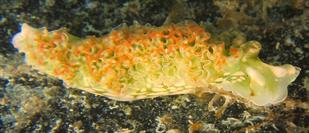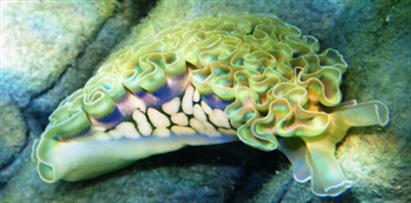



Elysia crispata
Size
To 10cm
Description:
Adults: Skin highly ruffled on back. Ruffles are very variable in colour, often green, bluish, reddish or other pastel shades. Large pale blothes along the sides.
Juveniles: Less ruffled when young and reduced green colour (as they retain (have fewer) chloroplasts).
Ecology
The primary food source of E. crispata is relatively unknown, although some individuals have been known to consume a diversity of algal species.
The greens and reddish colourations come from kleptoplasty. As algal food is being digested, the chloroplasts are absorbed into the cells lining the digestive tract and up into their parapodia. Chloroplast retention in E. crispata tends to last around 40 day. Given the variation in their diet, chloroplasts from different algal species have been found to be taken up into the same cells, functioning normally alongside the other.
Life Cycle
Simultaneous hermaphrodites, but cannot self-fertilise. Little is known of their mating behavior. Typically the egg mass is laid on flat, upright algae, and embryo development takes about 15 days. Newly hatched E. crispata demonstrate a dispersal dimorphis. Babies can either undergo intracapsular metamorphosis, or post-hatching metamorphosis, giving E. crispata variation in their dispersal strategy. This allows some clutches to remain stationary to that habitat, or allowing them to swim to a new habitat before metamorphosing.
To 10cm
Description:
Adults: Skin highly ruffled on back. Ruffles are very variable in colour, often green, bluish, reddish or other pastel shades. Large pale blothes along the sides.
Juveniles: Less ruffled when young and reduced green colour (as they retain (have fewer) chloroplasts).
Ecology
The primary food source of E. crispata is relatively unknown, although some individuals have been known to consume a diversity of algal species.
The greens and reddish colourations come from kleptoplasty. As algal food is being digested, the chloroplasts are absorbed into the cells lining the digestive tract and up into their parapodia. Chloroplast retention in E. crispata tends to last around 40 day. Given the variation in their diet, chloroplasts from different algal species have been found to be taken up into the same cells, functioning normally alongside the other.
Life Cycle
Simultaneous hermaphrodites, but cannot self-fertilise. Little is known of their mating behavior. Typically the egg mass is laid on flat, upright algae, and embryo development takes about 15 days. Newly hatched E. crispata demonstrate a dispersal dimorphis. Babies can either undergo intracapsular metamorphosis, or post-hatching metamorphosis, giving E. crispata variation in their dispersal strategy. This allows some clutches to remain stationary to that habitat, or allowing them to swim to a new habitat before metamorphosing.

| Ecological Descriptors | ||||
| Habitat | Size (cm) | Diet | Behaviour | Sex |
| R, Co | 10 | Veg * | I | SH |

Lettuce Slug
Lettuce Slug



286
*
* Some energy is gained from retained chloroplasts

287

